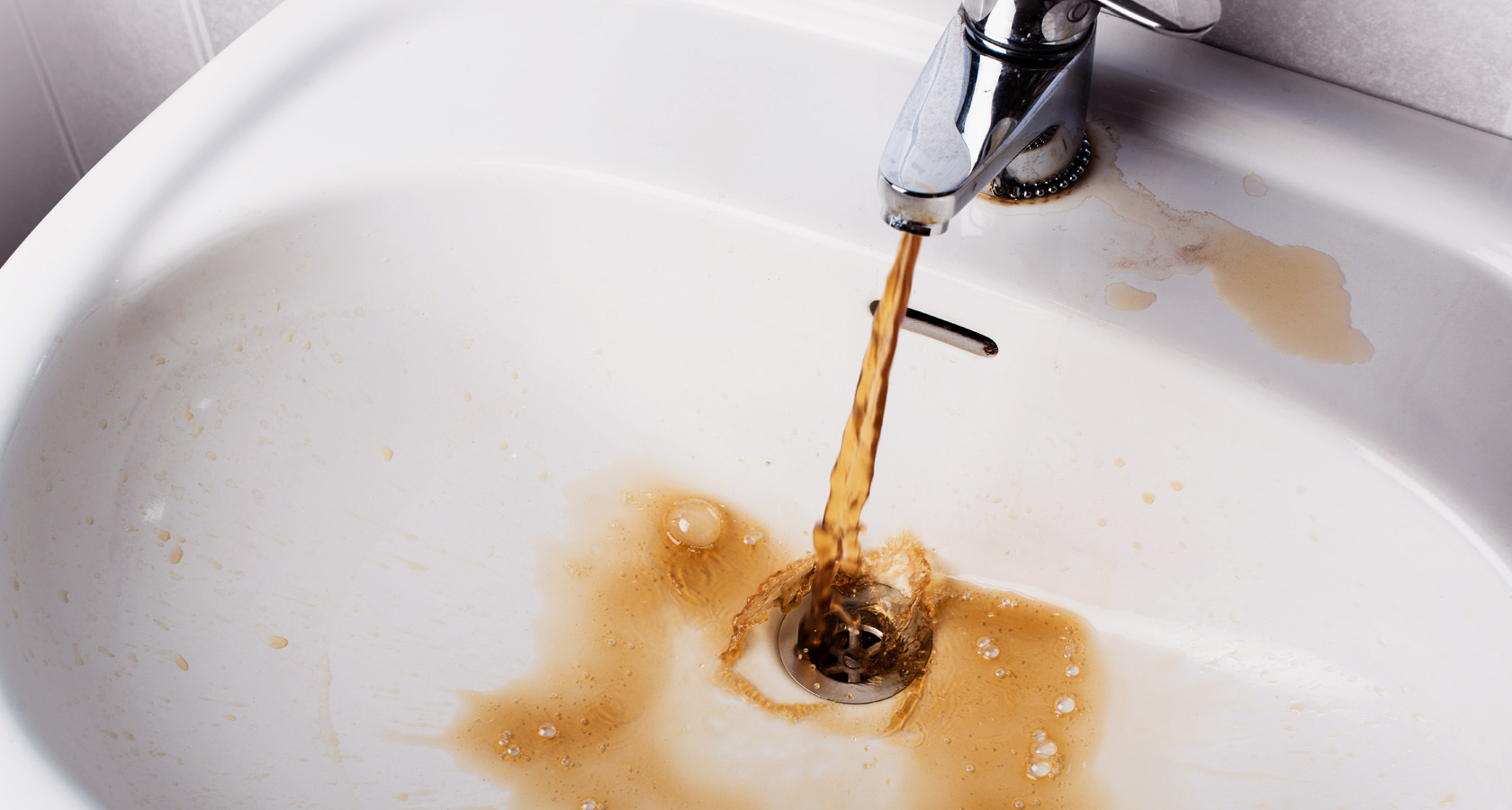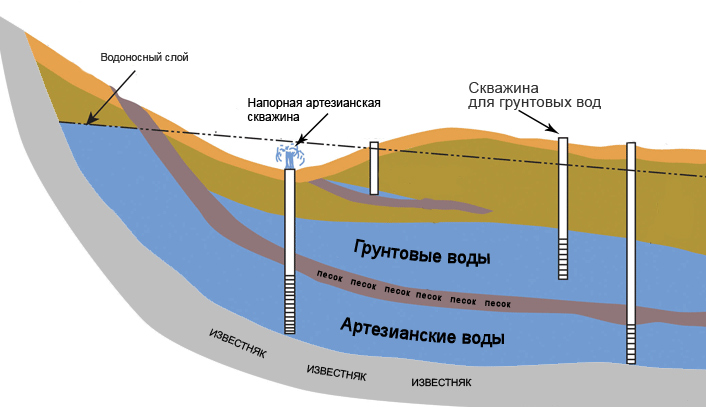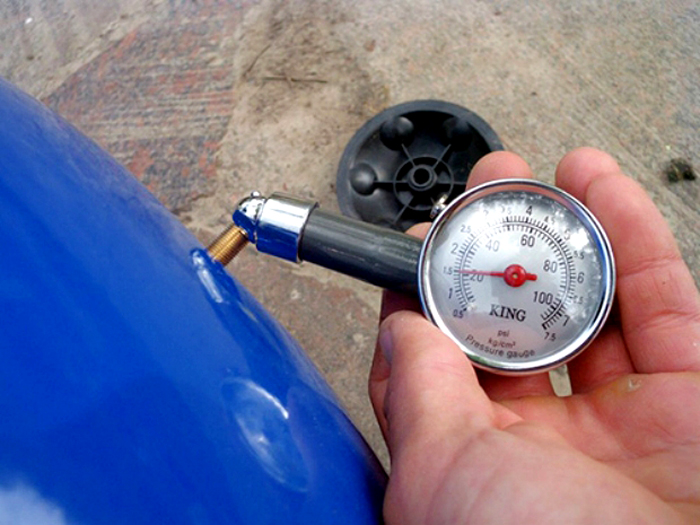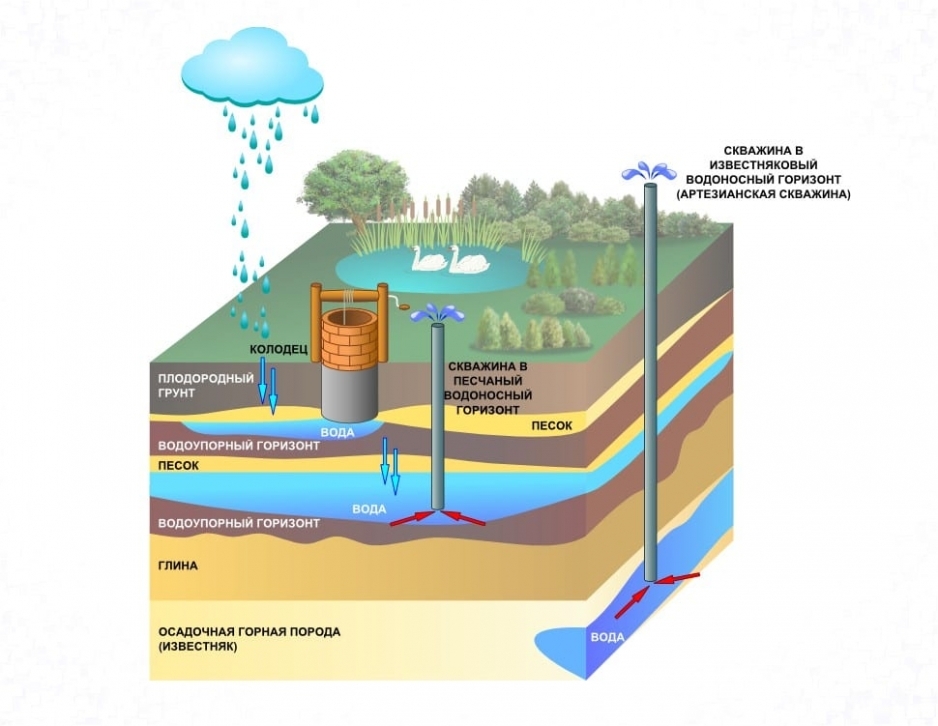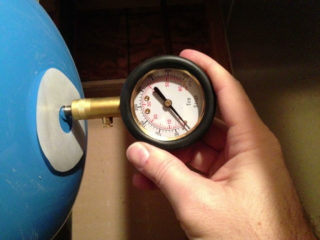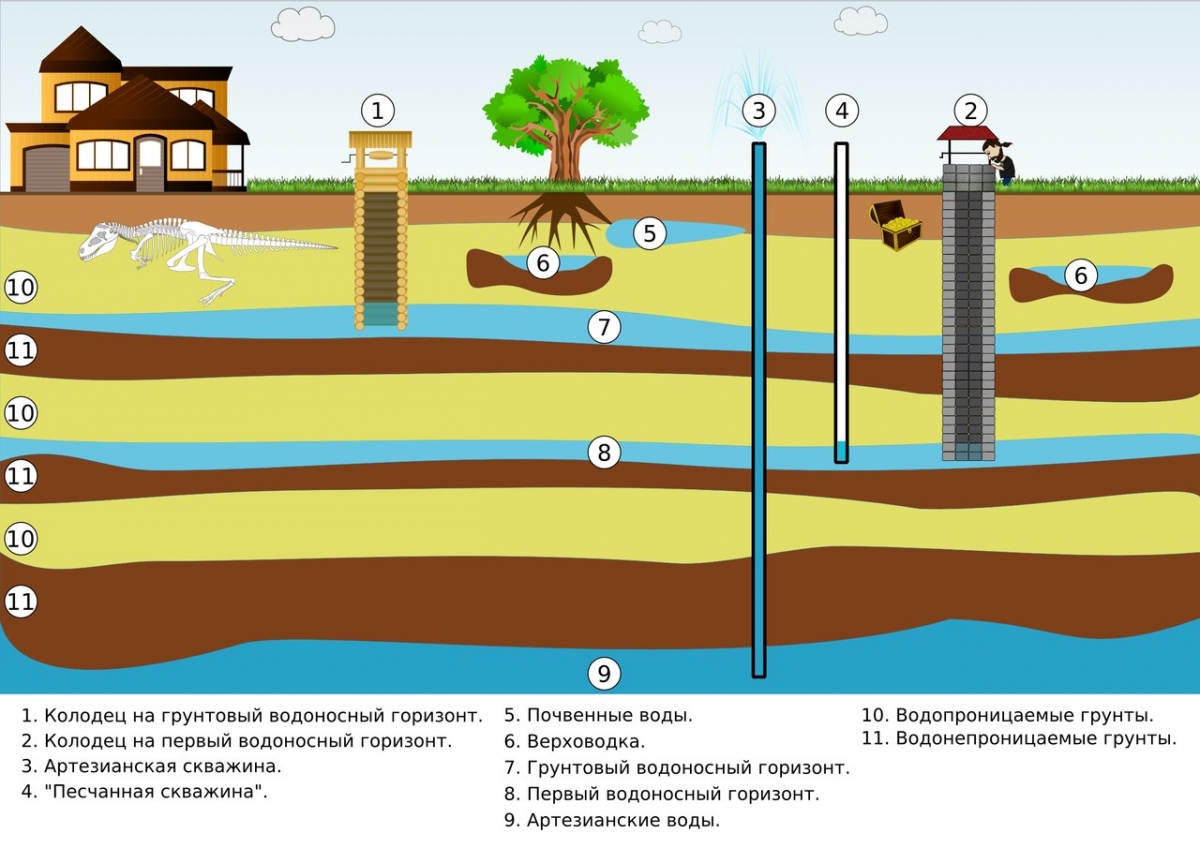To create an autonomous source in a summer cottage, suburban area, craftsmen prefer to drill a well. The water from it is as clean as possible, in contrast to the well, since the depth of the mine can reach 20, 50, 60 meters and even 100-140 m.Water wells can be drilled with your own hands if the aquifer lies no more than 25 meters down. With a strong deepening of the horizon, it will already be necessary to invite specialists.
Choosing the location and depth of drilling

Before forming the source shaft, you need to decide on the most convenient area for its location. There are two ways to determine the proposed location of the aquifer:
- Conducting reconnaissance surveys. It is performed by specialists, so you will have to pay for their services.
- Visual assessment of vegetation on the site and its other external features. Here you need to pay attention to those places where the greenery is lush and juicy even in extreme heat. In addition, it is over the zone with the aquifer that a thick fog spreads in the morning, and a swarm of midges swirls in the evenings.
The depth of the proposed formation, and hence drilling, can also be determined by two methods:
- intelligence;
- by interrogating neighbors: springs are often drilled in two adjacent areas to one aquifer, the main thing is that later the flow rate of both wells does not decrease.
You can approximately determine the depth of the reservoir and the vegetation in the area:
- hazel, willow indicate 3-5 meters of the horizon from the surface of the earth;
- viburnum, mountain ash, lilac - 10 meters;
- plants with a strong root system - the layer lies below the 15 m mark.
When drilling the source, you will have to go through the following layers:
- relatively soft wet sand;
- water-saturated liquid soils;
- deposits of gravel, pebbles;
- clayey quicksands;
- loam;
- clay.
Some of them can be handled with your own hands. Others can only be done with special equipment.
It is advisable to drill on the site even before the construction of a large cottage and other auxiliary buildings.
The norms for the location of the source on the site

It is important to adhere to specific distances when setting up the drilling site. There are a number of rules:
- the well is removed from the house at least 4-5 meters;
- from a cesspool, septic tank, waste discharge points - 25 m or more;
- from the fence - 4-6 meters.
At the same time, it is important to provide free access to the source or provide for a removable section of the fence. Where to do it, only the owner of the site decides.
Well types by depth
Depending on the depth to which a hydraulic structure is being drilled, the following types of sources are distinguished:
- Abyssinian well. It is drilled to a depth of 12 meters. The work can be done independently.
- Sandy water well. Goes to the level of 15-35 meters. Rarely up to 50 meters. A well on sand, if properly operated, lasts up to 25 years.
- Artesian source. Its depth is 50-150, and sometimes all 200 meters. The hydraulic structure has been serving for more than 40-50 years. However, the flow rate of the aquifer is so great that several cottages or even a small village can be fed from it at once.
An artesian spring requires a license, and the use of the water resource is taxed. Only this kind of operation of a hydraulic house structure is legal.
Types of drilling tools
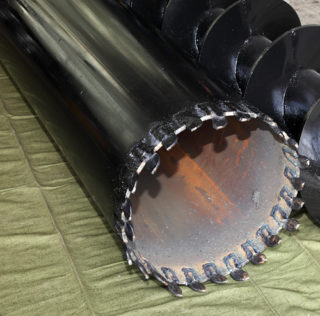
Distinguish between professional and household drilling equipment. In turn, specialized installations additionally differ in the method of overcoming the ground. For professional core drilling, the following are used:
- drill columns: diamond, tungsten, steel, victorious;
- a special pipe for the intake and removal of waste sludge;
- core tube;
- rods used to extend drill strings;
- flushing oil seal;
- couplings;
- adapters.
When working on rocks, rocks, any type of drill string wears out quickly and requires mandatory replacement.

For rotary drilling, a special drilling rig is used, the design of which looks like this:
- belt or lattice tower;
- rotor;
- drill string;
- engine;
- pumping equipment for mine washing;
- lifting equipment.
The rotational speed of the rotary machine depends on the engine power of the equipment.
For auger drilling, a technique is used, the main element of which is screw. Its blades are made of high-strength alloy, which allows it to overcome dense and even rocky strata.
From a household (non-professional) drilling tool, a garden auger, a sharp-edged steel sleeve or a bailer (a sleeve with inner blades) are used. A tripod winch serves as a lifting mechanism.
Professional drilling methods
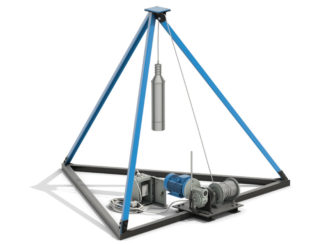
If specialists are involved in the formation of the source, the total cost of a well for water depends on its depth and the type of material for the casing. Craftsmen always consider the price per running meter. It already includes drilling, casing, flushing (pumping) the source and putting it into operation. If the arrangement of the caisson (special protective chamber) is to be done, this is an additional service that will have to be paid for separately.
In their work, professionals use the following drilling methods:
- Rotary. A screw auger is used, which rotates under the influence of a motor. Due to the transfer of the driving force from the motor to the cutting tool, it is deepened into the ground. In parallel, water is supplied here under pressure to wash out small parts of soil and rocks.
- Flushing drilling. Rotary-rotary penetration into the ground is also performed. In parallel, when passing through the upper layers, a clay mud is used. On limestone strata - clean water. With the help of the flushing fluid, the cutting element is cooled, the friction force is reduced, the walls of the mine are strengthened and the waste rock is lifted.
- Shock rope. It is used when passing shallow depths and relatively soft formations. The disadvantage of this method is the relatively low drilling speed. In the course of work, a powerful glass with a sharp end is driven into the ground and lifts the rock sample upward. Any soil that drillers remove from the mine can get into it.
- Rotational rope. The hollow rod is rotated into the ground. Waste rocks are brought to the surface using flush concreted water.
- Auger method. It is carried out by rotating a wide industrial drill, equipped with 2-3 blades. They also lift up the processed soil. Auger drilling is especially good for clayey soils. It cannot cope with limestone layers and underground boulders.
- Hydrodrilling. High-pressure water washes out ground rocks. The method is relevant for loose soils and shallow well depths (up to 15-20 meters).
- Perforated. The method is more likely to be performed manually. A thin pipe with a sharp tip is driven into the soil. The tuba grows as it deepens.Upon reaching the aquifer, the source is equipped with a pump. Using the perforated method, a well-needle is made in the country or in a small house for seasonal living. It is used for watering or for household purposes.
The price of a well (running meter of its drilling) varies somewhat depending on the way the professionals work, but only slightly.
Self-drilling methods
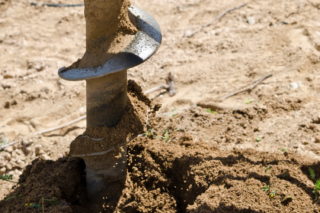
You can drill a source with your own hands in several ways.
Auger
A garden auger is used, which is manually screwed into the soil, starting from the formation of the upper hole. It is advisable to do this together. The order of performing work step by step:
- Grasping the handles of the auger, they screw it inward.
- Periodically, as the device deepens, the device is lifted up to extract the waste soils.
- The auger barrel is gradually built up with additional parts to deepen it even further. The procedure is performed using threads or clamps.
- Drilling is performed layer by layer until it reaches the aquifer.
- The walls of the shaft are reinforced with a casing.
- It remains to pump the source and equip its upper part with a head or a caisson.
With the help of the auger, you can go up to 20 m depth, but no more. The auger method of soil development is also used for the installation of bored piles or heat pumps. Here the mine is made shallower (up to 10 m).
Shock rope method (bailer)
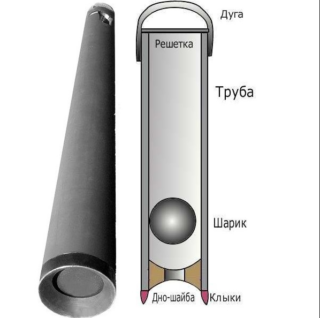
The development of the soil is carried out according to the principle of the drop of the driven nozzle from a height of 0.5-0.8 m. Under its weight, it cuts into the formation and absorbs rocks into its cavity. It remains to raise the bailer, free it from the volume of the earth and lower it down again.
To make it easier to get started, you need to prepare (dig) a drilling site. To do this, in the place of the proposed well, a hole is dug with dimensions of 2x2 meters. According to the project, its depth should be approximately 1.5 m. This zone makes it possible to firmly install the winch on a tripod and prevent the walls of the upper part of the shaft from crumbling.
The work should be done like this:
- Mount the winch in the center of the site.
- A thief is tied to it on a strong rope / cable.
- It is lowered sharply from a height of 1-1.5 meters and in this way hammered into the ground. So they cut into the soil.
- Raise the deepened glass, empty it, and deepen it again.
- The work cycles are repeated until the aquifer is reached. Then, a casing is installed inside the shaft.
For easier lifting of the thief with soil upwards, it is recommended to equip the winch with a motor. Under these conditions, jobs are completed faster.
What is the best way to drill
When it comes to forming a wellbore with your own hands, it is better to work with an auger. It goes well even in moderately hard rocks. But this method can only be used on dry seams. The auger is not suitable for quicksand and swampy areas.
Udrno-rope method is laborious, long, forcing you to first dig a site, but it allows you to destroy even rocks. The main thing is to fully adhere to the technological process.
Only professionals are invited to drill an artesian source using technology. In this case, there are simply no methods and techniques of drilling for independent searches for drinking mineral water.
Manual and professional drilling is performed only at a 90 degree angle to the aquifer. A curved shaft will not allow casing to be set without offset.
The drilling method is determined by specialists after prospecting surveys.
The cost and rates of the work of specialists
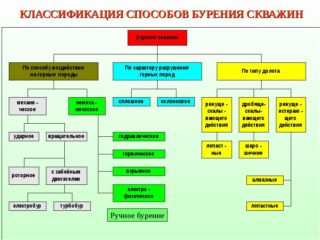
If the master decided to professionally drill a well for water, the price in Moscow and the region will vary between 1900-2100 rubles per running meter. The cost is influenced by the following parameters:
- the type of installation used;
- the type of soils (limestone, rocks, sands, clay, quicksand) that will have to be punched / drilled on the ground;
- casing material used (plastic or steel);
- column diameter;
- type of water intake pump installed.
To drill a well under water, it is better to contact trusted specialists who have good reviews and permission to perform work. They will perform preliminary geo-drilling, answer all relevant questions, and announce how much a full range of turnkey services will cost.
For professionals, the time of year for drilling in a private area does not matter. But it is better to look for an aquifer for water supply from mid-summer to early fall. Normally, work is completed in 2-5 days. The same specialists then provide warranty service for the well.

